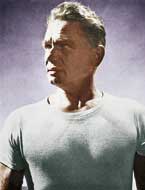What is Pilates?
Pilates is an ‘intelligent’ exercise developed by Josef Hubertus Pilates during and after World War 1 to assist bedridden patients to recover muscle strength after injury. The system employs specialised, simple machines using springs to teach body awareness and strengthen muscles without straining them, in a way that is complete and balanced. Many of these exercises can also be converted to mat work.The story of Josef Pilates is a fascinating one. As a child Pilates suffered numerous ailments, including asthma and rickets. He became interested in anatomy and fanatical about fitness, so much so that by the age of 14 he was in shape to model for anatomy charts. Yoga was also a big influence.
He first came to England from Germany in 1912 – legend has it that he arrived either as a boxer or circus performer. Still here at the outbreak of WW1 he was interned on the Isle of Man where he began to use his knowledge to help nurse his fellow internees as well as to teach karate and self-defence. To aid rehabilitation of bed-bound patients he began to devise imaginative resistance-training equipment, using bed springs and straps, which became the foundation for the development of later equipment.
At the end of the war Pilates went back to Germany , then emigrated to the States with his wife. They set up a studio in New York and continued to work together. The New York ballet community embraced Pilates as a method of building strength, suppleness and elongation of muscles, while avoiding bulk. Pilates died in 1967 at the age of 87. In recent years Pilates has again found favour, this time beyond the world of dance with anyone who wants to achieve fitness in a balanced and gentle way.
Pilates has proven beneficial for the rehabilitation of injuries and slowing down of osteoporosis, and also helps aid digestion. It is an exercise that can be adopted for anyone, young or old.
| 6 GOOD REASONS TO DO PILATES | |
| 1. | It will build strength without building bulk. |
| 2. | It’s a mind-body exercise that emphasises proper breathing, thus bringing mental as well as physical benefits. |
| 3. | By focusing on ‘core’ muscles – mostly those in the stomach and back – you can finally achieve the flat tummy you’ve always wanted. |
| 4. | It’s one of the safest exercises you can do. |
| 5. | Like Yoga you can start at any age, and carry on doing it for the rest of your life. |
| 6. | You will see yourself ‘grow’ as your posture begins to improve. |

Josef H. Pilates
